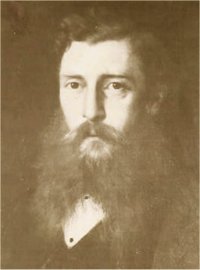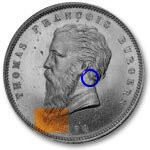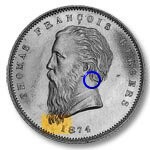 1874 "Coarse and Fine Beard"
Burgers pond
1874 "Coarse and Fine Beard"
Burgers pond
 1874 "Coarse and Fine Beard"
Burgers pond
1874 "Coarse and Fine Beard"
Burgers pond
There is no better reference book on this coin than "South Africa's First Gold Coin, Research on the Burgers Dies and Burgers Pond 1874" by Miss Matthy Esterhuysen. Esterhuysen was the Professional Officer in the Natural Cultural History and and Open Air Museum.
The coins were struck from the first gold found in S Africa and is,
like the Veld Pond, one of the country's great
rarities. 
Image right: President Thomas Francois Burgers (1834 - 1881) - state president of the Transvaal from 1872 - 1877
The Cape Commercial Bank opened bank branches at Pretoria, Potchefstroom and Pilgrim's Rest - their notes replacing the 1872 ZAR note displayed above.
After visiting the goldfields in late 1873 Burgers decided to produce his own indigenous gold coins - and on the 9th February 1874 wrote to J J Pratt, the Republic's Consul General in London sending him a portrait of himself and a sketch of the ZAR's coat of arms. His letter stated that the Government had resolved to have coins struck and included 300oz of native gold to be used for that purpose. (The Volksraad were unaware of his plans). Interestingly the gold used to strike the Burgers Pond was mined, like its famously rare partner the Veld Pond, at Pilgrim's Rest.
L C Wyon from the Royal Mint cut the dies from the portrait and the sketch. The coins were struck by Ralph Heaton and Sons of Birmingham. The first shipment of 695 Burgersponde was dispatched to the Republic in early August 1874 - these are known as the fine beard variety.
At a meeting of the Volksraad (Peoples Council) President Burgers presented 50 of his gold coins (the first strike - fine beard variety) to the members of the council. He was expecting strong recognition and admiration for producing the Republic's first indigenous coinage. Instead there was massive indignation. The members of the Volksraad were appalled and indignant that the President had seen fit to use the Republic’s money to produce a coin with his very own face on it. They remonstrated with him saying that it was a most egotistical and self centered thing to do.
The September meeting was one that Burgers would remember for a very long time. This quickly degenerated into massive debate, argumentation and erupted into general pandemonium. “He has produced these coins out of mere vanity and for his ego” exclaimed many of the members. “No, he has introduced our very own coinage” replied others.
To make matters worse the die broke - and a smaller second batch, the rarer coarse beard variety (seen below), numbering just 142 pieces was minted - Pratt keeping four of these coins for himself before they were shipped in October 1874. The President's beard appears much thicker and coarser in this second batch. (Esterhuysen's book identifies a large number of dies (over ten) that were used to mint the two sets of coins.)
We have displayed below the two widely accepted varieties of the Burgers Pond.
 |
Fine Beard Burgers Pond - mintage 695 piecesThe beard shows one thick front point, then two longer and thinner points followed by three shorter points. The front of the beard is wavy. The burr on the edge of the obverse of the coin shows a double ring. The impression of the effigy is very sharp. The lower neck hair is less pronounced than in the coarse beard variety. |
 |
Coarse Beard Burgers Pond - mintage 142 piecesThe beard shows four thick points, the front pair being shorter than the back. The beard is heavier and flatter in curvature. The burr is on the edge of the reverse. In addition the 8 in the date 1874 on some pieces appears to be a double 8. The lower neck hair is more pronounced than in the fine beard variety and can still be clearly identified in pieces VF or lower. |
As a result of the adverse reaction the coins brought in the Volksraad no more coins were struck.
The gold Burgerspond coins never circulated - being snapped up by burgers as keepsakes - often being mounted and being presented to loved ones as jewellery (like the mounted coin below). The honour of South Africa's first truely indigenous circulating coin was left to the Strachan and Co trade tokens - first circulated in the region known as Nomansland (East Griqualand) from 1874.
One of the largest and finest collections of Burgersponds can be found in the Mitchell collection.
The general recognition of these coins as circulating currency is a bit of a mis-nomer as they were generally kept as keep-sakes, often mounted as jewellery and not circulated by those burgers lucky enough to get or be able to afford one.
The first widely circulating currency in S Africa is the trade tokens of Strachan and Co which were first issued to the people of Nomansland (later East Griqualand) in the same year as the Burgerspond were minted (1874).
(Source: Matthy Esterhuysen "South Africa's First Gold Coin")
Burgerspond's attract a similar value to the Veld Pond - ie about US$50,000 for a piece in Unc condition. The piece above, although ex-mount, is worth about US$2,000
Value in 2005: The 1874 Coarse Beard Burgers Pond is highly sought after - valued at up to US$50,000 in Unc. Never seen on auction.
Pres Burgers
[1872: Zuid Afrikaansche Republiek (ZAR)
£1 Note] [1874: Coarse Beard Burgers
Pond] [1874: ZAR Patterns]
Pres Paul Kruger
[1892 Double Shafted Coins] [1892
- 1900: ZAR Paul Kruger Coins] [OFS Postal
Notes]
[1900 Pretoria Bank Notes] [1901
Pietersburg Bank Notes] [1902 Te Velde Bank
Notes] [Boer POW notes]
[1902: Veld Pond] [ZAR
Coins tampered with by Boer and British Prisoners of War (POWs)]
Boer War Siege notes and exonumia
[1893 Bechuanaland Border Police
Coins] [1899- 1900: Mafeking Siege Notes and Newspaper
Siege Slips]
[1900 Marshall Hole Bulawayo Card Currency]
Miscellaneous Exonumia
[Who is Paul Kruger]
[Title Deeds signed by Kruger]
[Lord Roberts' proclamation of Kruger's desertion
- Sept 1900]
[Contemporary Books on Boer War]
[Kruger's Unique Family Photo]
[Other Boer Coins & Medallions]
[Zuid Afrikaansche Republiek Coins and Notes]
[Web Site Text Site Map]
[Tokencoins.com Home Page]